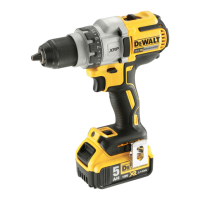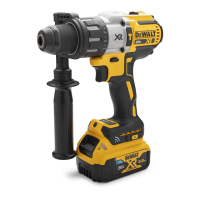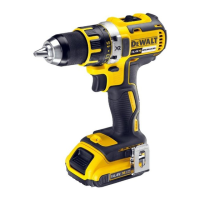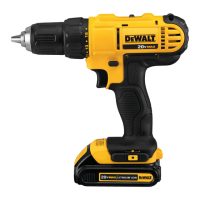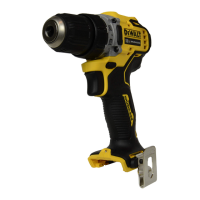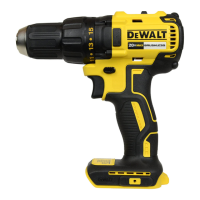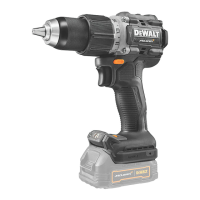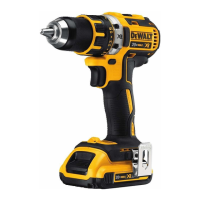34
ENGLISH
To select forward rotation, release the trigger switch and
depress the for ward/re verse control button on the right side of
the tool.
To select reverse, release the trigger switch and depress the
forward/reverse control button on the left side of the tool.
The center position of the control button locks the tool in the off
position. When changing the position of the control button, be
sure the trigger is released.
NOTE: The first time the tool is run after changing the direction
of rotation, you may hear a click on start up. This is normal and
does not indicate a problem.
Worklight (Fig. A)
There is a worklight
3
located just above the trigger switch
1
. The worklight will be activated when the trigger switch
issqueezed.
When the trigger is released the worklight will stay illuminated
for up to 20 seconds.
NOTE: The worklight is for lighting the immediate work surface
and is not intended to be used as a flashlight.
Mode Control Collar (Fig. C–E)
Your drill is equipped with a separate mode control
collar
6
to switch between drilling, screwdriving and
hammerdrillingmode.
Drilling (Fig. C)
CAUTION: When the mode collar is in the drill/
hammerdrill mode, the drill will not clutch out regardless
of the position of the torque adjustment collar
5
.
Rotate the mode control collar
6
so the drill symbol is aligned
with the arrow.
NOTE: The torque adjustment collar
5
may be set on
anynumber.
Screwdriving (Fig. D)
Rotate the mode control collar
6
so the screw symbol is aligned
with the arrow.
NOTE: The torque adjustment collar may be set to any
number at any time. However, the torque adjustment collar is
only engaged during screwdriving mode and not in drill and
hammerdrill modes.
Hammerdrilling (Fig. E)
CAUTION: When the mode collar is in the drill/
hammerdrill mode, the drill will not clutch out regardless
of the position of the torque adjustment collar
5
.
Rotate the mode control collar
6
so the hammer symbol is
aligned with the arrow.
Torque Adjustment Collar (Fig. C–E)
Your tool has an adjustable torque screwdriver mechanism for
driving and removing a wide array of fastener shapes and sizes.
Circling the torque adjustment collar
5
are numbers. These
numbers are used to set the clutch to deliver a torque range.
The higher the number on the collar, the higher the torque and
the larger the fastener which can be driven. To select any of the
numbers, rotate until the desired number aligns with the arrow.
Three-Speed Gearing (Fig. C–E)
The three-speed feature of your tool allows you to shift gears
for greater versatility. To select speed 1 (highest torque setting),
turn the tool off and permit it to stop. Slide the gear shifter
7
all the way forward. Speed 2 (middle torque and speed setting)
is in the middle position. Speed 3 (highest speed setting) is to
the rear.
NOTE: Do not change gears when the tool is running. Always
allow the drill to come to a complete stop before changing
gears. If you have trouble changing gears, make sure that the
gear shifter is engaged in one of the three speed settings.
Chucks
WARNING: Do not attempt to tighten drill bits (or any
other accessory) by gripping the front part of the chuck
and turning the tool on. Damage to the chuck and
personal injury may result. Always lock off trigger switch
and disconnect tool from power source when changing
acces sories.
WARNING: Always ensure the bit is secure before starting
the tool. A loose bit may eject from tool causing possible
personal injury.
Keyless Single Sleeve Chuck (Fig. F–H)
Your tool features a keyless chuck with one rotating sleeve for
one-handed operation of the chuck. To insert a drill bit or other
accessory, follow these steps.
1. Lock the trigger in the OFF position. Turn off tool and
disconnect tool from power source.
2. Grasp the black sleeve of the chuck
4
with one hand and
use the other hand to secure the tool as shown in FigureF.
Rotate the sleeve counterclockwise (as viewed from the
front) far enough to accept the desired accessory.
3. Insert the accessory about 19 mm into the chuck (Fig.G).
Tighten securely by rotating the chuck sleeve clockwise
with one hand while holding the tool with the other hand
(Fig.H). Continue to rotate the chuck sleeve until several
ratchet clicks are heard to ensure full gripping power.
To release the accessory, repeat Steps 1 and 2 above.
Be sure to tighten chuck with one hand on the chuck sleeve and
one hand holding the tool for maximum tightness.
Belt Hook and Bit Clip (Fig. A)
WARNING: To reduce the risk of serious personal
injury, turn tool off and disconnect battery pack
before making any adjustments or removing/
installing attachments or accessories.
WARNING: To reduce the risk of serious personal
injury, DO NOT suspend tool overhead or suspend
objects from the belt hook. ONLY hang tool’s belt hook
from a work belt.
WARNING: To reduce the risk of serious personal
injury, ensure the screw holding the belt hook is secure.
IMPORTANT: When attaching or replacing the belt hook or bit
clip, use only the screw
12
that is provided. Be sure to securely
tighten the screw.

